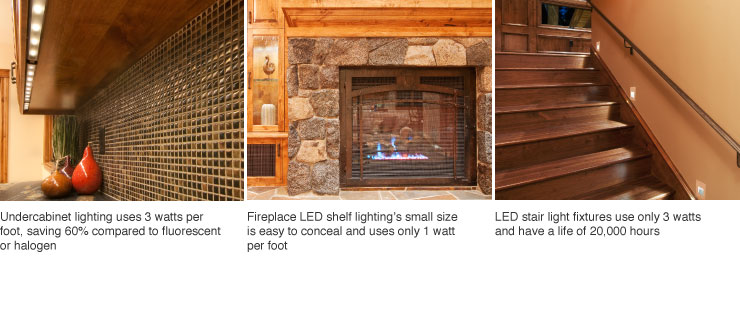GO GREEN
Light+Space Saves Energy With LED And Advanced Technology
As a LEED® Accredited Professional-owned business, Light+Space is committed to designing lighting using LED and advanced technology where feasible to increase energy efficiency and lessen negative impacts on this planet which we call home. Contact principal Lee Perko today to discuss your next energy-efficient lighting project or retrofit.
The following is a profile on Light+Space's LEED Silver Award-winning project at the Mill Creek Residence in Incline Village, Nevada.
TRPA 2011 BEST IN THE BASIN AWARD, GREEN BUILDING PROJECT
LEED for Homes Silver Certified— Mill Creek Residence, Incline Village, Nevada
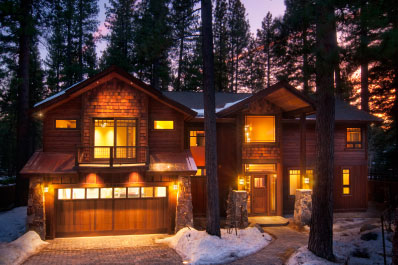 Mill Creek Residence, Phil Gilanfarr, Architect
Mill Creek Residence, Phil Gilanfarr, ArchitectAsa Gilmore, Photographer
"Congratulations! Our 1085 Mill Creek project was selected as the top project in its category and will be receiving a "Best in the Basin" award for 2011!"
—Jeff Miller, Advance Design & Construction
MILL CREEK RESIDENCE OVERVIEW
This 3,500 sq. ft. home was built as a "spec" home by a builder who is known for his artisan craftsmanship and believes in building healthy environments in the community and for clients. The home achieved LEED Silver and Energy Star certifications by meeting the LEED Advanced Lighting Package requirement that 60% of fixtures be Energy Star-rated. The owner/builder requested the use of LED technology and minimal use of fluorescent fixtures. This was successfully implemented with 64% energy star fixtures; 90% of which are LED sources.

USE OF LED FIXTURES
Energy Star-rated LED fixtures are featured in recessed lighting, 4" and 6", in the kitchen, mudroom, hallways, and bathrooms; recessed in-floor fixtures; linear up-lighting in cove in living room and media room; under-cabinet lighting in kitchen. LED technology is also used in the step lights, bar pendants, linear in-cabinet lighting, and decorative bar pendants.

FINDING THE RIGHT FIXTURES
The home features warm crafted finishes and required the use of warm white sources, which proved to be a challenge. During design, there were a limited number of energy star rated fixtures available with warm white CCT suitable for insulated ceilings that would meet the budget limitations of a spec home.
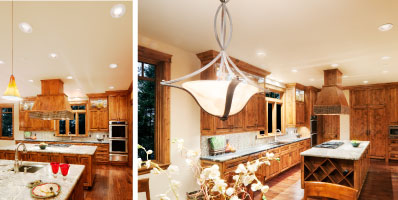
COMPARING FIXTURE PERFORMANCE
During construction, the builder hosted open houses to educate the community about the requirements of Energy Star and LEED, dispelling the myth that all green homes have solar panels. One open house held during framing provided the opportunity to construct a mock up comparing incandescent, fluorescent, and LED downlights. Illuminance meter readings and popular opinion were noted. This exercise convinced the builder, electrician, and lighting designer that LED could meet light level and aesthetic requirements. The kitchen recessed lighting consumes 216 watts, 50% of fluorescent and 20% of incandescent wattage typically required.
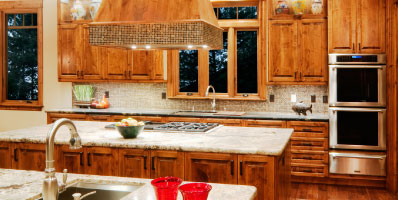
DECORATIVE ENTRY LIGHTING
The entry required a custom modified fixture to provide the correct scale, meet budget, and provide visual interest from the street. Additional decorative incandescent fixtures were limited to Entry sconces and coordinating surface fixtures, Stair sconces, Dining pendant, and vanity sconces. This application shows that LED and incandescent lighting can peacefully co-exist, while ensuring energy budgets are successfully met.
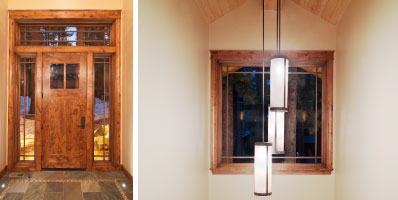
THE LAYERED LIGHTING APPROACH
The owner required unobtrusive lighting for the master bedroom for general and reading tasks. Louvered fixtures with MR16 narrow spot lamps are used for precise beam control, reduced glare, and energy efficiency.
Halogen used in low-use areas such as bedrooms and master bath, where full range dimming required. Lighting control system allows turning off all layers of lighting when leaving individual rooms and turn off of all upon leaving home.
A layered lighting approach was incorporated to illuminate the ceiling, provide mid-range lighting from wall sconces, and accent lighting for artwork, architectural features and reading tasks.

ENERGY & BUDGET CONSIDERATIONS
Dimmers are provided throughout the home to allow varied levels of light, depending on the use of each space, which also extends lamp life and reduces energy costs. The home is designed at 1.8 watts per square foot.
A minimal-lighting approach was used by placing lighting only where activities and tasks would occur, and on specific art walls. This approach also minimizes ongoing maintenance.

MILL CREEK RESIDENCE ENERGY USE
The outside entry of the Mill Street Residence is highlighted by a 20 W metal halide fixture hidden in the overhang, which shines down on the quartz tile of the entryway. The entire residence has a HERS rating of 66 (only an 85 rating is required for Energy Star certification). The Mill Street Residence uses only 1.6 watts/sq. ft. for interior lighting.

MILL CREEK RESIDENCE HIGHLIGHTS
